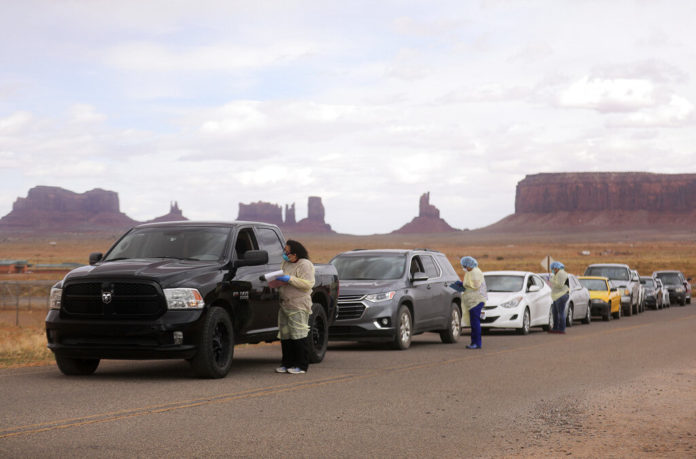
U.S. health officials say coronavirus infections are beginning a renewed surge across the Navajo Nation and bordering areas that may peak in mid-May — a sign that the worst has yet to come in one of the nation’s hardest-hit rural areas.
In a press briefing Thursday, officials with Indian Health Service and the Centers for Disease Control and Prevention described efforts to containing the virus on remote stretches of the Navajo Nation. A widespread lack of indoor plumbing and crowded housing conditions are interfering with efforts at social distancing and isolation, despite local curfews and humanitarian aid deliveries, they said.
“We anticipate that we have begun our surge,” said Loretta Christensen, chief medical officer for the Indian Health Service in the Navajo area. “We expect a full peak by around May 10 and we are very hopeful that we have prepared for our resources to manage that because that will get us to about our capacity at all of our hospitals.”
A COVID-19 outbreak at a detox facility was highlighted as a major factor behind surging infections in the city of Gallup and surrounding McKinley County that overlaps indigenous Zuni Pueblo and portions of the Navajo Nation. Intensive care beds within that county are full and critical patients are being transferred to Albuquerque as hospitals there surpass standard intensive care capacity and activate triage plans to take on more patients, New Mexico state health officials said.
The infection surge across the Navajo Nation — which overlaps parts of New Mexico, Arizona and Utah — comes as President Donald Trump on Thursday said the federal government will not be extending its coronavirus social distancing guidelines and that he was anticipating a major financial rebound in the coming months. Trump plans to visit Arizona next week.
Democratic New Mexico Gov. Michelle Lujan Grisham expressed concern that the president’s travel to the Southwest U.S. could increase the risk of COVID-19 transmission.
“I will welcome President Trump with open arms in New Mexico if he is masked, he is wearing gloves for anything that we are going to attend, there are no mass gatherings or rallies, and he’s bringing Air Force One with the supplies that we need in the state of New Mexico,” she said during a videocast news conference from the Statehouse.
A new Trump campaign ad highlights supportive comments by Lujan Grisham about the federal response to the coronavirus.
“It is the political season,” Lujan Grisham said. “All fair, but that travel and that mass gathering creates risk.”
Amid new virus outbreaks at nursing homes in Gallup near the Arizona-New Mexico state line, the mayor published an open letter asking the governor to invoke rarely used emergency powers state’s Riot Control Act to contain COVID-19 transmission.
Lujan Grisham said she planned to act on the request quickly as she instates new emergency health directives through May 15 that relax restrictions on some nonessential businesses — though not in the northwest of the state where COVID-19 infections are on a steep upward trajectory.
Starting Friday, nonessential businesses can offer curbside service and deliveries, while gun shops, veterinary offices and state parks reopen. Hospitals can restart noncritical surgeries and procedures.
The state is extending its ban on gatherings of more than five people, a 14-day quarantine for inbound air travelers. Indoor shopping malls, gyms, salons, theaters, liquor stores and casinos will remain closed.
Republican Party Chairman Steve Pearce said the new order continues to put small businesses at a disadvantage against walk-in big box stores that have been deemed essential.
“I just can’t understand why it’s OK to have 200 people in Walmart and it’s not OK for two people to be in the local clothing store,” he said. “It’s discriminatory against locally owned businesses.”
At the Navajo Nation, infections initially surged on the western side of the vast reservation and now extend the southern and eastern reaches of Navajo Nation.
“There are multiple factors that have have resulted in the high numbers,” Christensen said. “The social distancing is challenging in our area. You know, we’re encouraging hand-washing and good hygiene, and we have 30% of homes that unfortunately don’t have running water.”
Henry Walke, a division director for emergency infections at the Centers for Disease Control and Prevention, said the CDC has deployed two field teams to the Navajo Nation at the request of tribal authorities. Federal authorities have opened to two alternative care centers in the region that can expand bed capacity at hospitals by caring for recovering COVID-19 patients with oxygen treatment and other therapies.
There were 1,977 confirmed COVID-19 infections and 62 deaths on the Navajo Nation as of Wednesday, according to federal and tribal officials.
In New Mexico’s rural McKinley County, confirmed infections climbed to 923 as of Wednesday, surpassing the infection total in Albuquerque and accounting for about 30% of infections statewide.
Republished with the permission of the Associated Press.














